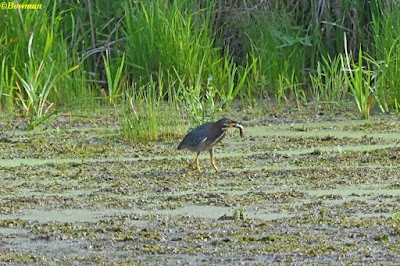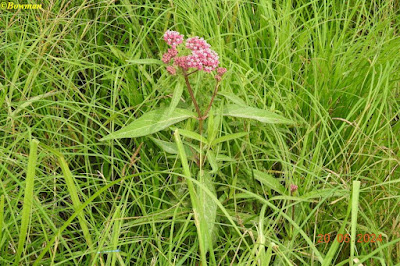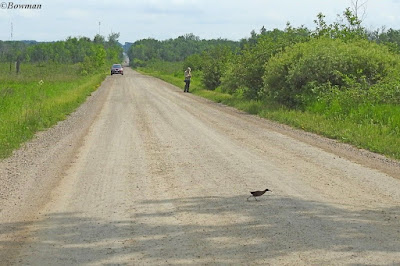June 20, 2024
Birding Report by Jane Burgess
There was a very
unusual sighting on this trip, not the bird, but how the bird was
sighted. Ken saw a Ruby-crowned Hummingbird out the side window as it
flew by the car and he said he saw it so very clearly. We were all
amazed.
We stopped at the pond just before
Cobden, the last time we were there the only birds we saw were Canada
Goose and Red-winged Blackbirds. This time it was totally different,
first up a Green Heron fishing, we saw it catch a fish and then another
(we saw at least 3 Green Herons during the day). Then two Virgina Rails
were spotted and in the sky a Bald Eagle. As we were about to leave a
female Mallard and her brood came into view. At the boat launch we saw a
few Common Terns, heard Red-eyed Vireo, White-breasted Nuthatch,
American Goldfinch and a Great Blue Heron.
At
the Ross Road Swamp, we were greeted with the Trumpeter Swan family, all
9 of them . I was so glad that none of the cygnets had been anyone's
lunch. We got out of the vehicle quickly and rushed over to take
photos. Really rushing over was not necessary, the family stayed around
all the time we were there. The cygnets must be at least 2 months
old. Now for some swan trivia -- males are called cobs, females pens
and a group of swans can be referred to by different nouns -- when in
flight a wedge or a flight, also a bevy, a bank or a herd. They have a 8
foot wingspan but larger males can have a wingspan up to10 feet. Swans
mate for life - if Pen dies, the Cob usually do not find another
partner but Pens do find another mate. Clutch size is usually 4 to 6
eggs, so the Ross Road Swans have a slightly larger than normal size of a
family. Incubation time is about 32 to 37 days and the cygnets stay
around for about 6 months when the parents chase them away. Breeding
does not happen until they reach 4 to 7 years. Average life time in
the wild is 12 years, but in a protected environment can reach 30
years. Enough swan trivia.
Just opposite the
swans a Common Gallinule was very close to the road, maybe 10 - 12 feet
away from us. Its concern was preening, so it did not pay attention to
us.
Once we got our fill of the swans, we
started walking the road. The Marsh Wrens were singing and so much
easier to see than the last visit. They must be between raising the
next brood. I guess the males are telling the females what good singers
they are!!
While walking back to the vehicle,
Kayla let Bill know there was Least Bittern flying. We were so lucky,
we got to see three Least Bitterns during the day. One that seemed to
be flying directly toward the road to where some of us were standing,
then a sharp right landed not too far away from us and then disappeared
into the reeds. Their bright buffy colour is so distinctive.
We
walked to where we have been successful at seeing the Sora, but before
getting there a Eastern Kingbird nest was spotted, with 2 babies in it.
The parents were close by and did fly in to feed them. The babies are
very close to fledging (see photos). Then we went to see if we could
find a Sora. Bill played Sora and who should appear was a Virginia
Rail who walked up very close to Barbara and Kayla. One Virginia Rail
even walked to the other side of the swamp (see photos).
Time
to move on, so we decided to check out the other side of the swamp.
While stopping, we looked at the little creek and a Great Blue Heron was
spotted. Then a Green Heron flew up from very close to the vehicle.
Guess it was not interested in our conversation.
At
some point in the day Bill said we would do a second pass of Ross Road
but we would not stop unless we saw something good. We saw Common
Gallinule babies, little puff balls. We stopped and Bill and Ken took
photos. The Gallinules swam quickly and out of sight in no time.
We had our lunch at Lac Dore beach. Not one single bird on the lake.
We
decided we would go to Osceola dump. No problem finding it. On the way
there we heard Ovenbird, Chestnut-sided Warbler and House Wren. The
field beside the road going to the dump was full of singing Eastern
Meadowlarks, just love their song "spring of the yeeear". Walking
toward the dump I saw something high in the sky, I yelled to Kayla and
Ken, high in the sky and I pointed. But they were at the bottom of the
hill and there were tall trees. Thank goodness they kept watching and
the bird flew over the road. What I saw was striped and broad wings.
We all came to the conclusion it was Broad-winged Hawk. We walked the
road beside the dump, seeing lots of Common Ravens and Turkey Vultures.
I got distracted looking at butterflies, flowers and such. The others
walked on, then Barbara and Kayla decided to walk back and I joined
them. Bill and Ken eventually returned and reported seeing a Northern
Cardinal and two Brown-headed Cowbirds. The Cowbirds were with some
cows, imagine that.. Ken spotted two Kestrels on the hydro line and I
heard "fire, fire, where, where, here, here". I turned and saw an
Indigo Bunting on a hydro line near the dump. I said to Kayla, turn
around and look at the line, you owe me $10. She was happy to see the
Indigo Bunting as it had eluded her on many birding outings. We all
eventually got back in the vehicle and of course we saw some more
interesting action in the sky, it turned out a Cooper's Hawk was being
harassed by a Kestrel. Oh isn't nature intriguing.
Time
to go home, Bill, we have had a request for ice cream. Ok, we will
stop in Cobden. The shop is closed Wednesday and Thursday, Kayla
checked where the nearest ice cream places were, Shawville or Renfrew.
Not going to Quebec, Bill opted for Renfrew. On the way to Renfrew a big
bird was seen high in the sky, "stop the car Bill, get out Ken". Gee I
can get bossy, but it had to be done quickly, here is hoping Ken can
identify the big bird. Thank you Kayla for treating us all to ice
cream cones -- delicious. While we were enjoying the cones, I noticed
two pigeons getting it on, forplay and the nasty deed. Took maybe a
minute in total.
On the way home on the 417
close to Ottawa, we saw a lot (maybe 20 or 30) of motorcycle police
with lights flashing. Bill thought maybe some sort of honour guard.
Home by 6:15 and out of the house by 6:30 to watch a soccer game.
Thanks Bill for driving and thank you Bill and Barbara for the photos.
Species Seen
- Wild Turkey
- Double-crested Cormorant
- European Starling
- American Crow
- Red-winged Blackbird
- Ruby-crowned Hummingbird
- Eastern Kingbird
- Green Heron
- Virginia Rail
- Mallard
- Bald Eagle
- American Robin
- American Redstart
- Common Tern
- Ring-billed Gull
- Red-eyed Vireo
- White-breasted Nuthatch
- American Goldfinch
- Great-blue Heron
- Tree Swallow
- Common Grackle
- Song Sparrow
- Bobolink
- Red-tailed Hawk
- Turkey Vulture
- Mourning Dove
- Savannah Sparrow
- Rock Pigeon
- Yellow Warbler
- Common Yellowthroat
- Marsh Wren
- Trumpeter Swan
- Swamp Sparrow
- Common Gallinule
- Least Bittern
- Great-crested Flycatcher
- Wood Duck
- Wilson's Snipe (h)
- Green Heron
- Warbling Vireo
- Chipping Sparrow
- Barn Swallow
- Brown Thrasher
- Blue Jay
- Killdeer
- Veery
- Grey Catbird
- Black-capped Chickadee
- Ovenbird
- Chestnut-sided Warbler
- House Wren
- Eastern Meadowlark
- Broadwing Hawk
- Brown-headed Cowbird
- Northern Cardinal
- Indigo Bunting
- Kestrel
- Cooper's Hawk
- Northern Flicker
- Common Nighthawk
- Osprey
Critters Seen
- Leopard Frog
- White-tailed Deer
- Northern Cloudywing
- Mourning Cloak











































No comments:
Post a Comment